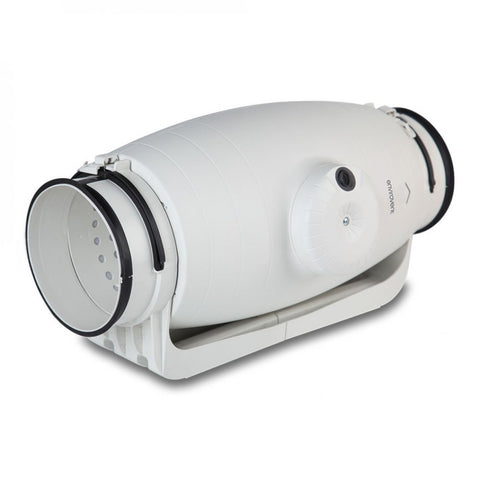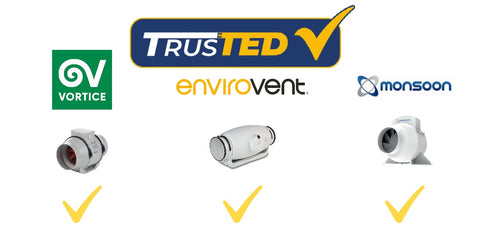Inline Extractor Fans - A Complete Guide
Inline Extractor Fans - The Ultimate Solution

Are you looking for an efficient and effective way to manage the air quality in your home or commercial space? Look no further, as inline extractor fans are the answer to your ventilation needs.
Inline extractor fans are a type of ventilation system that can be installed directly into an air duct to provide maximum airflow. They are designed to remove unwanted air, moisture, and unpleasant odors from your indoor environment, creating a clean and fresh atmosphere for you to enjoy.
Benefits of Using Inline Extractor Fans
-
Increased Air Quality: Inline extractor fans help to improve the air quality in your indoor environment by removing unwanted air, moisture, and unpleasant odors. This will ensure that you can breathe in fresh and clean air, promoting a healthier and more comfortable living space.
-
Energy Efficient: Inline extractor fans are energy efficient and use less power compared to traditional ventilation systems. This means that you will be able to save money on your energy bills while still ensuring that your indoor environment is well-ventilated.
-
Quiet Operation: Inline extractor fans are designed to operate quietly, so you won't be disturbed by noisy ventilation systems. This makes them ideal for use in homes, offices, and other quiet environments.
-
Easy Installation: Inline extractor fans are easy to install and can be integrated into your existing ventilation system. This means that you won't have to go through the hassle of installing a separate ventilation system.
-
Durable and Long-Lasting: Inline extractor fans are made from high-quality materials, ensuring that they are durable and long-lasting. This means that you won't have to replace your ventilation system frequently, saving you time and money in the long run.
Are inline extractors better?
Inline extractor fans are becoming the most popular option for domestic ventilation. This is because they are at least twice as powerful as your standard axial bathroom fan. As long as you have space in the ceiling void/loft an inline extractor fan will be your best option. Another major benefit is that the extractor is not installed physically into the room so there is less noise when running!
See our full range of Inline Extractor Fans Here!

Do inline fans push or pull air better?
Inline Extractor fans can be used to either push or pull air, depending on their orientation and the desired airflow direction.
When pushing air an inline fan overcomes resistance from the ducts or other obstacles in the airflow path, such as filters or grilles. When air is pulled through a duct or ventilation system, it can create negative pressure within the system, which can cause air to leak out of the ducts or other unintended places.
That being said, there are situations where pulling air may be more appropriate, such as when trying to exhaust air from a room that has no external ventilation. In such cases, the inline fan would be installed in a way that pulls the air out of the room and into a duct or other ventilation system.
Ultimately, whether an inline fan is better at pushing or pulling air depends on the specific needs of the ventilation system and the orientation of the fan within that system.
Where should an Inline Extractor Fan Be Placed?
Inline fans are typically installed in ductwork to provide ventilation or air movement in a particular space. The placement of inline fans depends on the specific application and the type of ventilation required.
Here are some common placement options for inline fans:
-
Between two sections of ductwork: This is the most common placement for inline fans. The fan is installed between two sections of ductwork, and the air is forced through the fan as it travels from one section of ductwork to the next.
-
Near the source of ventilation: In some cases, it may be more effective to place the inline fan near the source of ventilation. For example, if you are using an inline fan to ventilate a bathroom, you may want to place the fan near the ceiling in the bathroom to quickly remove moisture and odors.
-
At the end of a duct: If you are using an inline fan to create positive pressure in a room, you may want to install the fan at the end of a duct to force air into the room.
It's important to note that the placement of an inline fan should be carefully considered to ensure optimal performance and energy efficiency.
How Big Of An Inline Fan Do I Need?
The size of an inline fan that you need will depend on several factors, including the size of the room or space you are trying to ventilate, the desired air exchange rate, and the resistance to airflow caused by any ductwork or other components in the ventilation system.
To calculate the size of the inline fan you need, you can follow these general steps:
-
Determine the volume of the space you want to ventilate. You can do this by multiplying the length, width, and height of the space in feet.
-
Determine the desired air exchange rate. This is the number of times you want the air in the space to be exchanged with fresh air per hour. A typical air exchange rate for a residential bathroom is 8-10 times per hour, while a kitchen may require 15-20 times per hour.
-
Calculate the required airflow rate. Calculating the cubic meters per hour (m³/h) of ventilation required depends on the volume of the space that needs ventilation and the number of air changes per hour (ACH) desired. The ACH is the number of times the volume of air in the room is replaced in an hour.
Here's the formula:
Ventilation (m³/h) = Volume of space (m³) x ACH
To calculate the volume of space, multiply the length, width, and height of the room in meters. For example, if a room is 5 meters long, 4 meters wide, and 3 meters high, the volume of the space is 5 x 4 x 3 = 60 m³.
-
Consider the resistance to airflow. If you have long duct runs or other components that may impede airflow, you may need to choose a larger fan to compensate.
-
Choose a fan that can deliver the required airflow rate. You can find this information in the fan's specifications. Look for the fan's airflow rating in cubic feet per minute (m³/h) and choose a fan that can deliver the required m³/h.
How far can an inline fan extract?
Inline fans can comfortably sit on duct runs of up to 10m – and remember, the extraction rate is far higher to start with. So the shorter the duct run the more effective the fan will be. 10 Meters is the standard length of an inline extractor fan's capabilities, but be aware of bends in the ducting as a bend will add 1 meter.

Different Brands - What's the difference?
The Inline Extractor Fans we stock have been carefully chosen from our many years of experience and testing at our HQ!
Envirovent SILMV Inline Fan Range
Envirovent's inline extractor fan range is known to be the most silent in the industry. They are very impressive, they don't look like your bog standard inline fan. They look great but the technology within this unit, and how it's been built allows it to be virtually silent!
Vortice Inline Extractor Fan Range
Vortice's range of inline duct fan is cost-effective, powerful, and quiet. They are designed with simplicity in mind and are a top choice for a quick, easy and reliable installation and will work efficiently for years to come!
Monsoon Inline Extractor Fan Range
The Monsoon UMD fan is specially designed with an optimised case and an aerodynamic impeller, ensuring the best combination of high air capacity, powerful pressure and low noise level. Due to the high efficiency motor the fan has low energy demand but excellent aerodynamic performance.
See our full range of Inline Duct Fans here!

